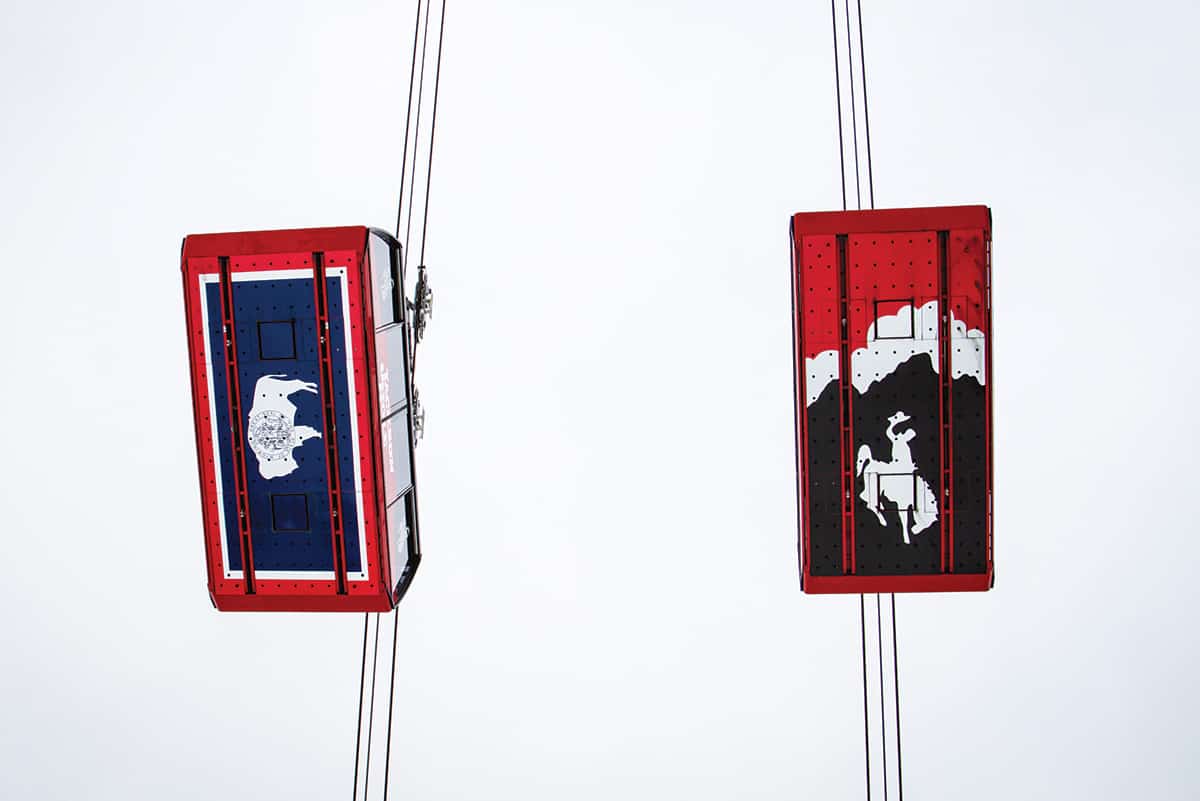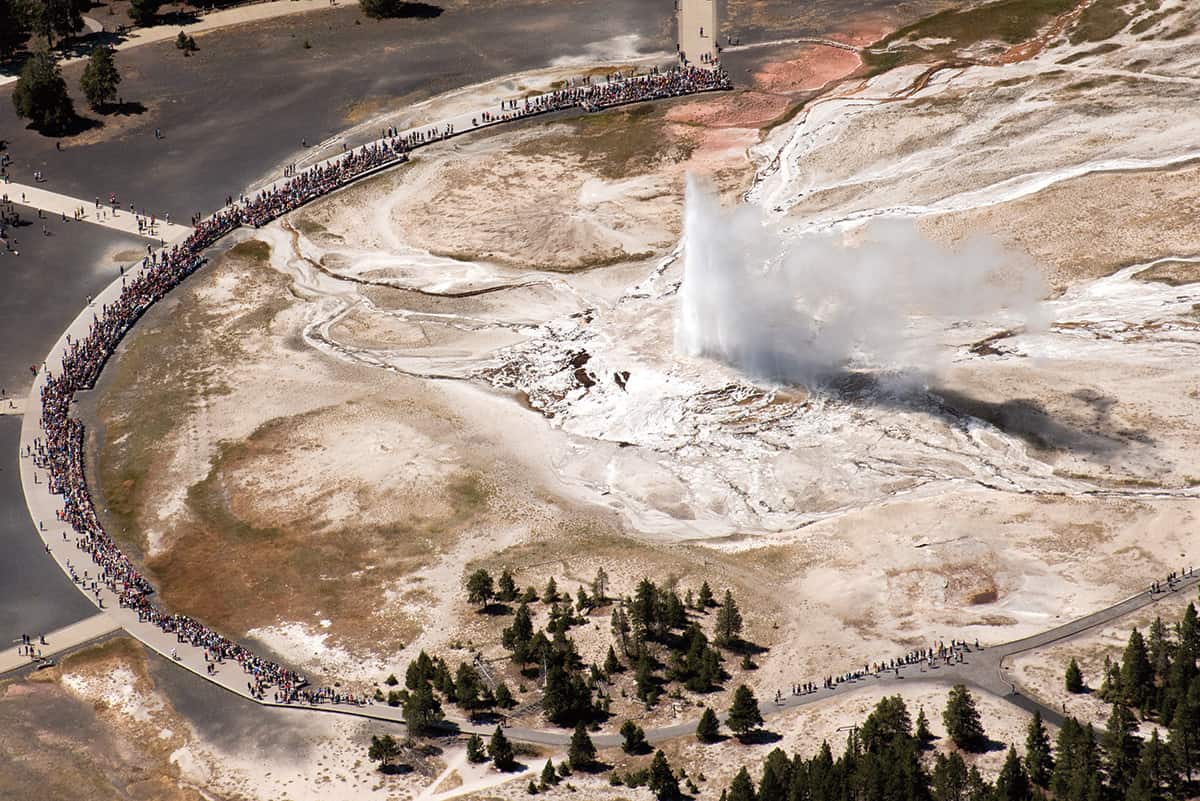Read The
Current Issue
Saving Jackson Hole
Jackson Hole is known for its wildlife, wildlands, and Wild West image—a brand that is as authentic as it is alluring, and successful. But what does the valley’s popularity mean for its wildness?
By Molly Absolon

“JACKSON HOLE.” THESE two words lure like a siren song, pulling people from all over the world here to see wildlife and towering peaks, to ride a horse, ski powder, or experience a little bit of the Old West. Jackson Hole’s popularity is rooted in its proximity to Grand Teton (GTNP) and Yellowstone National Parks, but the valley has its own identity: There is a Jackson Hole brand, even if there is no single mastermind behind it.
Groups that promote tourism to the valley—local businesses and events; state, town, and county government; the Jackson Hole Chamber of Commerce; and the Jackson Hole Travel & Tourism Joint Powers Board (JHTTB), a seven-member committee created in 2011 to increase off-season tourism—do not collaborate on how the area presents itself to the outside world. The National Park Service (NPS) uses the Tetons and Yellowstone in its marketing campaigns, while Travel Wyoming, the state’s official tourism office, heavily promotes both parks. Articles tout Jackson as a destination for western and wildlife art. And Jackson Hole Mountain Resort (JHMR) has a marketing team that works diligently on its own messaging and branding.
It is the ads of the NPS, JHTTB, Travel Wyoming, and JHMR that are the most ubiquitous and widespread. Started as a small ski area with big dreams, Jackson Hole has become one of the best ski resorts in the United States and is one of the few family owned resorts to break the 500,000 skier-day mark. Its early reputation for being “too hard, too cold, and too far” has been forgotten, thanks to tens of millions of dollars of investments to improve snowmaking, establish more lift access, create more intermediate ski terrain, enhance base facilities, and partner with airlines to provide direct flights to Jackson from major cities all over the U.S. During its fiftieth anniversary year (2015-16), the mountain saw more visitors than ever before, in part because of its very focused and successful brand: “The Last of the Wild West.”
That brand, which revolves around the iconic bucking horse and rider logo, capitalizes on nostalgia for the valley’s cowboy heritage and a bit of the tough-guy mystique left over from the early days. It is used in conjunction with images of the area’s abundant wildlife and its spectacular setting to create a feeling of adventure and excitement. “When you think cowboy, you think untamed spirit,” says Bill Lewkowitz, JHMR’s business development director and a resort employee for thirty-two years. “That’s what we are about. We’re kind of rough around the edges, but people tend to like that.”
While it is JHMR that officially uses “The Last of the Wild West” identity, wild and western is the natural personality of the entire valley; the messaging of other groups is a variation on that theme. Travel Wyoming ads include photos of bison in front of the Tetons. A recent JHTTB ad campaign was “Your Inner Wild is Calling.” The Grand Teton Music Festival, a seven-week summertime series of classical music concerts, has posters of musicians in a field of wildflowers in front of the Tetons.
Groups have different-but-the-same messaging in large part because so much of Jackson Hole is public land, whether national park, forest, or reserve. This gives the region its incredible wildlife resource, recreational opportunities, and conservation history—its wildness and West-ness. And, as Jackson Hole has become better known, more and more people are coming. Since 2000, the town of Jackson’s population has grown 135 percent. “Jackson’s economic success depends on our amazing resources,” says Aaron Pruzan, the owner of Rendezvous River Sports and a member of the JHTTB since its inception. “How do we move forward in a way that is good for the town’s economy and residents, and also respects place and the values we get from this place?”
Behind mineral extraction, tourism is Wyoming’s No. 2 industry. But as the state faces declining energy revenues, tourism is seen as the golden egg. (Federal coal lease and mineral royalty payments have shrunk by 50 percent, or $500 million in the last decade, and Wyoming’s 2017-18 budget faces a $156 million shortfall.)
The national parks remain the main draw for tourists. In 2016, 4.257 million people visited Yellowstone National Park, a 3.9 percent increase from 2015 and up more than 20 percent from 2014. In GTNP, 2016 was the third consecutive year of visitation growth. Over the last four years, visitation to GTNP has increased 23 percent. “Growing up, in elementary school we learned about Yellowstone,” a tourist from China explained last summer. “It is unlike anywhere else in the world, and it has long been a dream to see it in person.” In February 2016, Brand USA—a private-public partnership created by the 2011 Travel Promotion Act—released an IMAX movie to theaters around the world called National Parks Adventure. Narrated by Robert Redford, the film “takes audiences on the ultimate off-trail adventure into the nation’s awe-inspiring great outdoors and untamed wilderness,” including Grand Teton and Yellowstone.
Tourists spent $3.3 billion in Wyoming in 2015, and the industry is responsible for 32,000 jobs, or 12 percent of the state’s workforce. Statewide visitation grew 4.2 percent in 2014 and generated $170 million in local and state tax revenues. According to Diane Shober, the executive director of the Wyoming Office of Tourism, without tourism, the state would have to generate roughly $730 more per person to make up for the lost revenue.
“We leverage [our national parks] to draw visitors to all parts of Wyoming. We talk about an emotional experience. Our marketing conjures up things like honor, America, the last bastion of wide-open spaces. But a brand only works if there is truth underneath it,” she says.
HEREIN LIES THE rub. Jonathan Schechter, an economist and the founder and director of the Jackson think tank Charture Institute, says the potential paradox for a community like Jackson is that by selling a brand—the Wild West or an adventurous mountain lifestyle, for example—you monetize that image, and in monetizing it, its authenticity is lost.
Jeff Golightly, the former president and CEO of the Jackson Hole Chamber of Commerce and a founding member of the JHTTB, points out that it isn’t the crowds of visitors that threaten Jackson’s authenticity. “We saw 1 percent growth in [hotel] occupancy over the last four years,” he says. “We’re full. You can’t get fuller than full. Two hotels have been built in [the town of] Jackson in the last twenty years, and, at the same time, four were torn down. Overall, the number of rooms in town has remained about the same for twenty years. I think tourism is the sacrificial lamb people want to throw into the volcano to slow down growth. But, really, we aren’t growing any faster than other mountain towns in the West; in fact, we are growing slower than some.” Golightly concedes that more people are moving to Jackson Hole, but says desirable communities throughout the world are getting more crowded.
“It’s a question of demographics,” says Christian Beckwith, the founder and director of the annual SHIFT gathering, which promotes working together to champion the country’s public lands. “The population of the United States is projected to grow from 300 million to 650 million. There will soon be 7 billion people in the world. These people are going to go somewhere. Jackson Hole is an incredibly desirable place. What’s happening here is happening in all desirable places.” Beckwith believes that understanding the overlap between growth and sustainability is critical for the protection of the public lands and wildlife that make the valley so unique.
So it seems that part of the solution to keeping Jackson Hole wild may lie in today’s perceived problem of overcrowding. “We need to appeal to more people,” Beckwith says. “Outdoor recreation is an incredibly powerful vehicle to get people outside to fall in love with a place.” And according to Beckwith, it’s when people love a place that they want to protect it.






